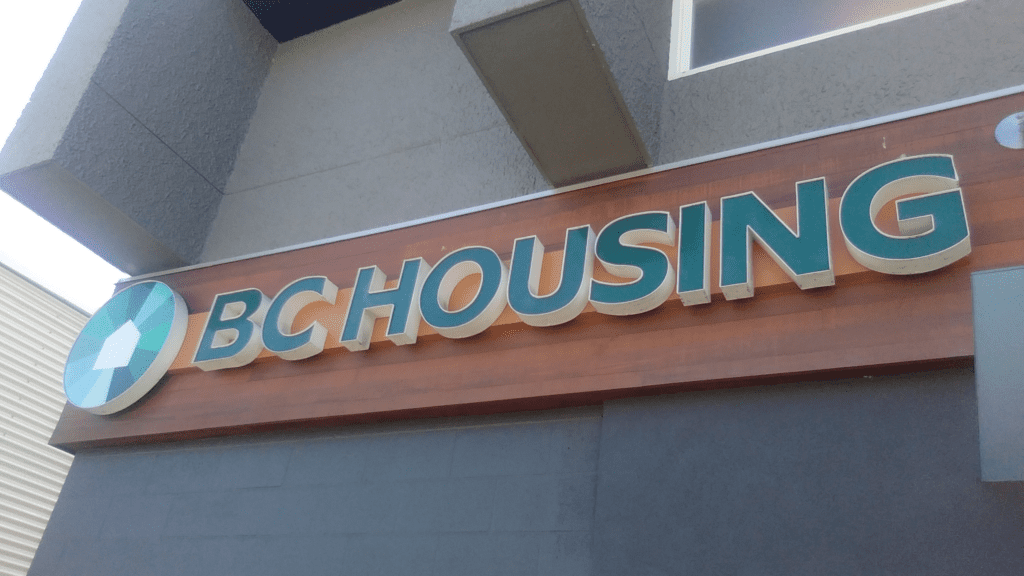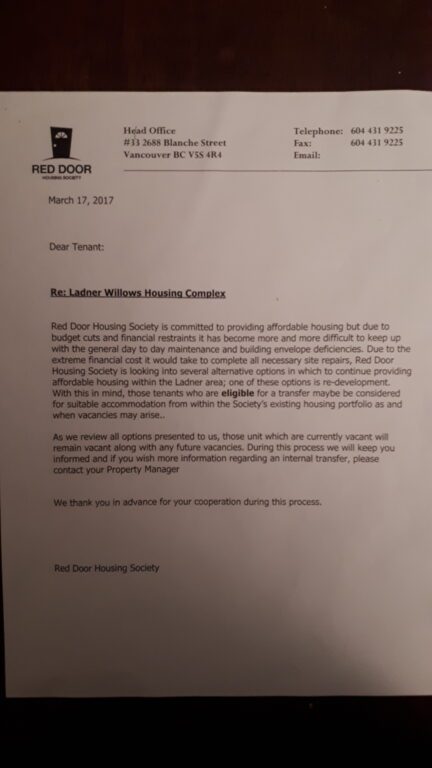Why does Ladner Willows Sit Half Empty While Disabled People Sleep Rough?
Our subsidised housing system is rotting, both literally and figuratively, at the peak of a homelessness crisis. Does BC Housing have a solution, or is it part of the problem?

Recently I learned there were no less than four vacancies in the supportive housing complex I live in due to lack of referrals from eligible organisations such as BC Housing. It’s gotten me to wonder how many suites out there are sitting empty while waiting lists swell to obscene levels.
Meanwhile, a disabled grandmother called Leona living in Vancouver was wondering the same thing. Reduced to squatting the basement of an abandoned house, she asked BC Housing to explain her predicament even as there were vacancies at Ladner Willows, a 40-unit affordable housing complex operated by the Red Door Housing Society.
Those who already know of this location may gasp upon reading that name and wish she’s googled it first. I’ll come back to this.
Weeks later, Leona received a reply from BC Housing, although not the one she wished for:
The redevelopment plan BC Housing refers to was to convert the current building into a 150-unit facility, originally slated for completion by February 2023. It currently sits in bureaucratic limbo due to the city of Delta’s decision not to approve the project in June 2022, citing concerns about increased density, and is since left with no plausible path forward—even though Red Door Housing claimed as early as 2019 that the rezoning had already been approved.
I won’t take a stance pertaining to the council’s decision to block the project. While I don’t share its concerns pertaining to density, other notable objections were raised, such as the lack of a plan to relocate the remaining tenants. Red Door Housing has also earned the reputation of being a slumlord, allowing its buildings to get infested by mould after extensive water damage due to lack of maintenance, and neighbours objected to enabling the society.
I reached out to BC Housing requesting comments, specifically asking whether it still had any plans for Ladner Willows; it had yet to reply by publication time. This article may be updated if I belatedly get an answer (don’t hold your breath).
Instead I’ve been in contact with Elizabeth Zbitnoff and Janna Martin. The former is currently a tenant at Ladner Willows facing eviction, while the latter has already been forced out after her suite was emptied and her belongings confiscated. Both have complained of black mould in their units and have been subjected to retaliation since.

Through them I’ve learned that Red Door Housing has been aggressively pressuring remaining tenants to vacate their apartments, using unconscionable tactics such as spurious eviction notices; Zbitnoff claims she was sent one invoking failure to perform repairs as grounds for eviction, which is bound to raise eyebrows, unit maintenance being the province of the landlord. Other tenants, some allegedly semiliterate or insufficiently proficient in English, may have been compelled to sign a mutual agreement to end a tenancy portrayed as an eviction notice.
The whole scheme looks like classic renoviction by purposeful neglect, except carried out by a nonprofit housing society. Which is very odd, both because the nonprofit part makes the plot pointless and because it requires the complicity of BC Housing. It led me to wonder: who actually profits from this? The answer, as counterintuitive as it may be, is likely the nonprofit housing society.
This is where it gets weird, and a bit technical, but indulge me for a moment as we follow the money.
First, a nonprofit wishing to ratchet up rents needs a legal loophole. Rent in subsidised housing is variable and based on the tenant’s income, which is called rent-geared-on-income (RGI) housing. While only those with low income are eligible, the rent can go up as a tenant’s income improves. The issue has already been raised by Red Door Housing in a dispute against a tenant who’d been loaned a large sum the court determined counted as income, justifying a sharp rent increase.
Of course a nonprofit society housing a massive number of tenants ineligible for subsidised housing risks seeing its tax-exempt status revoked and rent hikes overruled, right? Well, there may be a circumvoluted way around that, and that’s where BC Housing comes in.
Properties like Ladner Willows were transferred to nonprofit housing providers using a Nonprofit Asset Transfer (NPAT) scheme, under which BC Housing sold them the properties, then paid off their mortgage with subsidies, under the pretext of raising funds in the short term for upcoming projects, and also claiming without evidence that it will somehow improve housing affordability in the long term.
If the above doesn’t make sense to you, that’s normal. The Auditor General couldn’t make sense of it either, while BC Housing refuses to disclose its rationale, invoking public interest immunity. Right.
And this is where things get juicy. Multiple documents on BC Housing’s website describe a plausible scheme through which a nonprofit having been in a contractual relationship with BC Housing could actually generate a profit by increasing rents. You see, such a nonprofit is perpetually exempt from residential tenancy regulations, even after the agreement expires. The agreement may terminate once the mortgage is paid, and the subsidies end, but the society is still shielded from regulations market landlords are bound to, as if it were still operating like a subsidiary of BC Housing, so it can keep renting RGI units without the eligibility criteria for subsidised housing.
Not only that, it can keep its tax-exempt status by claiming its profits were an incidental and unanticipated windfall resulting from the agreement termination or some unforeseen complications. You know, like by redeveloping properties that have incidentally been allowed to rot by unremediated water damage, or raising the rent of tenants once eligible for subsidised housing after their income has unexpectedly been revised upward. And of course by accidentally kicking out poor tenants not worth milking. Oops.
This way a nonprofit can compete against the market with an unfair advantage, exempt from both regulation and taxation. To avoid legal challenges, all it has to do is reinvest its profits into new developments.
As I pointed out, this requires the complicity of BC Housing, which doesn’t have an obvious motive to play along. That being said, it isn’t unreasonable to presume such a motive exists. After all, BC Housing’s board of directors was fired last year after a forensic audit exposed widespread irregularities pertaining to its dealings with Atira, another nonprofit housing society; BC Housing’s former CEO was since found in conflict of interest after giving preferential treatment to a provider run by his wife, and Atira was compelled to return over two million dollars in surplus.
Although speculative, this may be the answer Leona is looking for: she has to squat the basement of an abandoned house because neither BC Housing nor Red Door Housing wish to backtrack on a doomed ploy to turn a massive profit off formerly subsidised housing. On the bright side, even her current accommodations may prove healthier than the alternatives Red Door keeps off the market.

Last year, leadership at both BC Housing and Red Door Housing has been replaced; the latter had Bailey Mumford assume Susan Snell’s role as executive director in May, right before Red Door submitted its proposal to the city of Delta. It remains to be seen whether the institutions, under new leadership, will commit to their predecessors’ agendas. Given the notorious extent of the rot in both, I wouldn’t bet on either turning itself around.
Discover more from Rulebreakers
Subscribe to get the latest posts sent to your email.



